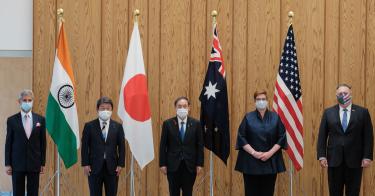Among the Democratic front-runners for president, Joe Biden was seen as boasting arguably the longest foreign policy resume and most centrist disposition. Just over a month after the election, however, a matter of nomenclature has some in the community of experts watching the Indo-Pacific sounding the alarm bells.
Just two weeks after China’s nationalist mouthpiece insisted a Biden administration should abandon the “Indo-Pacific” concept adopted by the Trump administration and most of America’s key strategic partners in the region, Biden signaled he may do just that. In an article for The Atlantic and in public remarks December 8, Biden reverted to the old “Asia-Pacific” terminology now preferred by Beijing.
If the U.S. is indeed planning to abandon the Indo-Pacific without a compelling strategic rationale, it would represent a strategic blunder. Here’s why.
ABANDONING THE INDO-PACIFIC?
Biden first raised eyebrows in his defense of his pick for secretary of defense, General Lloyd Austin. An article for The Atlantic entitled, “Why I Chose Lloyd Austin as Secretary of Defense,” surprisingly made no mention of the Indo-Pacific or, for that matter, China. “Multiple mentions of [Gen. Austin’s] Middle East experience,” noted analyst Blake Herzinger, “but not a single word about his preparedness to tackle our largest challenge.”
In public remarks the following day, Biden explained that Gen. Austin was “just as committed as I am to rebuilding and modernizing our alliances, from the Asia-Pacific, to Europe, and around the world.” Gen. Austin spoke at the same event, underscoring the importance of maintaining alliances, “including in the Asia-Pacific, in Europe, and around the world.”
Four years ago, both statements would have been extraordinarily mundane. But the U.S. government has devoted considerable effort to transitioning its diplomatic language and strategic thinking away from the “Asia-Pacific” to the newer “Indo-Pacific” while socializing the change among partner nations throughout the region.
After the Democratic Party’s 2020 platform also opted to use Asia-Pacific instead of Indo-Pacific, it’s fair to ask whether Biden is planning to abandon the Indo-Pacific concept simply because it carries an association with the Trump administration. That would amount to an unforced error based on a fundamental misreading of the Indo-Pacific.
ORIGINS OF THE INDO-PACIFIC
The intellectual architect of the contemporary Indo-Pacific concept was Japanese Prime Minister Shinzo Abe. In the mid-to-late 2000s, Abe began pioneering the concept, first referring to a“dynamic coupling” of the Indian and Pacific Oceans in a 2007 speech to the Indian parliament titled “Confluence of the Two Seas.”
For Abe, the Indo-Pacific concept advanced two objectives. First, he saw it as a superior geostrategic construct and natural successor to Asia-Pacific. Due to a variety of complementary trends—globalization, the growth in maritime trade, India’s rise, China’s expending westward reach—the old boundaries of the region were being blurred and redrawn.
The Indian Ocean, South China Sea, and broader Western Pacific were becoming profoundly interconnected, as were East and South Asia. Important security and economic trends were transcending and ignoring the artificial boundaries of the 20th century. (That phenomenon was on display this year, when along the old dividing line between South and East Asia, Indian and Chinese soldiers engaged in deadly combat for the first time in over 40 years).
Second, Abe sought to pair this new geostrategic concept with a normative vision for the Indo-Pacific. He argued Japan should work closely with the U.S. to promote a vision of economic and political freedom in region, defend the global commons and freedom of navigation, support the rule of law, and oppose the use of force or coercion. He believed Japan and the U.S. should enhance strategic collaboration with India and Australia, in particular—a democratic “Quad” of the Indo-Pacific.
While he avoided implicating any country by name, Abe very much had China on the mind. In 2004, long before China’s Wolf War diplomacy and artificial islands in the South China Sea made international headlines, tensions between Beijing and Tokyo began simmering over provocative Chinese actions around the disputed Senkaku/Diaoyu islands. By the time Abe was elected to his first term as prime minister in 2006, China rise was rapidly gaining steam and Abe was convinced the territorial dispute would only get worse, and Chinese foreign policy would only grow more aggressive in tandem with its expanding capabilities.
Abe’s Indo-Pacific concept initially had few takers. The Quad idea gained some initial traction, producing an inaugural diplomatic meeting and Quad military exercise in 2007. However, the initiative collapsed in early 2008. At the time, the four democracies were less aligned on the nature and scale of the threat China posed and the appropriate response.
THE INDO-PACIFIC GAINS TRACTION
By the mid-2010s, however, the Indo-Pacific began gradually entering the strategic discourse, championed at first by strategic thinkers in Australia. Analyst Rory Medcalf contended in 2013 that the Indo-Pacific “recasts the mental map of some of the most strategically important parts of the globe…recognizing that the accelerating economic and security connections between the Western Pacific and the Indian Ocean are creating a single strategic system.”
The Indo-Pacific was formally adopted by the Australian government in its 2013 Defense White Paper. It soon began appearing in government statements issued by Japan, India, Vietnam, Indonesia, and others. By the mid-2010s it was sporadically making its way into the U.S. strategic discourse and in 2014 U.S. military commanders began referring to the “Indo-Asia-Pacific.”
The Obama administration never fully embraced the Indo-Pacific concept, though it was occasionally featured in articles, remarks, and initiatives by cabinet officials. In its second term, however, the Obama administration did begin strategic messaging about the importance of upholding a “rules-based order” in the region, mirroring some of the ideas articulated in Abe’s vision for the Indo-Pacific.
One month after being re-elected with a sweeping mandate, Abe delivered a speech in August 2016 announcing a “Free and Open Indo-Pacific Strategy.” In November 2016, days after Donald Trump was elected president, Abe championed his new “Free and Open Indo-Pacific Strategy” in a meeting with Indian Prime Minister Narendra Modi.
The following June, as the U.S. government was preparing to host Modi for President Trump’s first state visit, the White House began adopting the Indo-Pacific terminology. That October, Secretary of State Rex Tillerson explained that the “world’s center of gravity is shifting to the heart of the Indo-Pacific.” One month later, the Quad was revived after a ten-year hiatus. Officials from the four countries gathered to “discuss measures to ensure a free and open international order based on the rule of law in the Indo-Pacific.”
The Trump administration soon began articulating its own vision for a “free and open Indo-Pacific,” sharing many similarities with Abe’s concept. The Indo-Pacific was then adopted in the 2017 U.S. National Security Strategy and by 2018 was being widely used in the U.S. government and on Capitol Hill. That year, the U.S. military renamed its Pacific Command (PACOM) the new Indo-Pacific Command (INDOPACOM). In addition to the other Quad capitals, the Indo-Pacific also found traction among other like-minded partners including France and, later, the UK.
INDIA, CHINA AND THE INDO-PACIFIC
India, which established a new Indo-Pacific division in its external affairs ministry in 2019, has today become a particularly vocal advocate for the Indo-Pacific. In February 2020, Indian External Affairs Minister S. Jaishankar explained: "Indo-Pacific is a reality, a naval reality, a political reality, a trade reality, an economic reality. Why?...Because Indo-Pacific means we cannot deal with the Indian Ocean and Pacific Ocean as two separate arenas."
Jaishankar has even defended the Indo-Pacific from criticism levied by India’s former patron, Russia. Earlier this year, Russian Foreign Minister Sergei Lavrov insisted the Indo-Pacific was designed to “contain China” and “Indian friends are smart enough to understand this threat and not get into it.” This month, Lavrov added: “India is currently an object of the Western countries’ persistent, aggressive and devious policy as they are trying to engage it in anti-China games by promoting Indo-Pacific strategies, [and] the so-called ‘Quad.’”” One week later, Jaishankar retorted: “Only a person in denial of globalization will actually contest Indo-Pacific."
Russia’s objections to the Indo-Pacific pale in comparison to China’s, which has colorfully described the Indo-Pacific and the Quad as “gas and speculation.” While the Indo-Pacific concept was never explicitly billed as an anti-China initiative, its focus on sustainable and high-quality infrastructure is explicitly at odds with China’s Belt and Road Initiative. Its commitment to the rule of law and opposition to the use of force is explicitly at odds with China’s coercive tactics and aggressive maneuvers in the South China Sea and along the border with India.
Thus, Beijing has always viewed the Indo-Pacific and the Quad with great skepticism; as thinly-veiled attempts to contain China’s rise. Two weeks before Biden’s adoption of “Asia-Pacific,” China’s nationalist mouthpiece, the Global Times, implored him to abandon the Indo-Pacific in an article titled, “Biden should revamp Asia-Pacific path, ditch Indo-Pacific idea.”
To some outside observers, it appeared as if Biden was catering to China’s demand. Even to more sympathetic eyes, “Biden’s failure to mention China or the Indo-Pacific strategic landscape in his justification of SECDEF pick Austin will be viewed with great concern by allies and partners in the region.”
CONCLUSION
Prime Minister Abe was ahead of his time in championing the Indo-Pacific. He was right about the growing challenges China would pose, the dissolution of artificial boundaries, the merging of the Indian and Pacific Ocean theaters, the value of developing the Quad and fostering alignment among four uniquely aligned democracies, and the importance of promoting a positive vision for stability, prosperity, and freedom in the region.
For its part, the Trump administration was right to embrace the Indo-Pacific construct, articulate its own vision for a Free and Open Indo-Pacific, and coordinate with partners and allies to popularize the new construct.
A Biden administration would be wrong to undo that work, especially if it’s motivated principally by political considerations, by the desire to mollify Beijing, or by the mistaken belief that the Indo-Pacific is inextricably tied to the Trump administration. The Indo-Pacific concept was birthed in the Indo-Pacific and in the days after Biden’s article and remarks, it continues to be used by U.S. partners there.
It is possible Biden’s use of the Asia-Pacific this month does not represent a concrete or lasting shift away from the Indo-Pacific concept. Notably, Biden did refer to the Indo-Pacific in readouts he provided of several congratulatory calls with the foreign leaders of India, Japan, and South Korea. In those instances, he used “secure and prosperous Indo-Pacific” rather than “free and open Indo-Pacific.” If properly developed, that formulation could represent a reasonable evolution to a dynamic concept. A reversion back to the Asia-Pacific with no compelling strategic rationale, by contrast, would represent a grave miscalculation.




